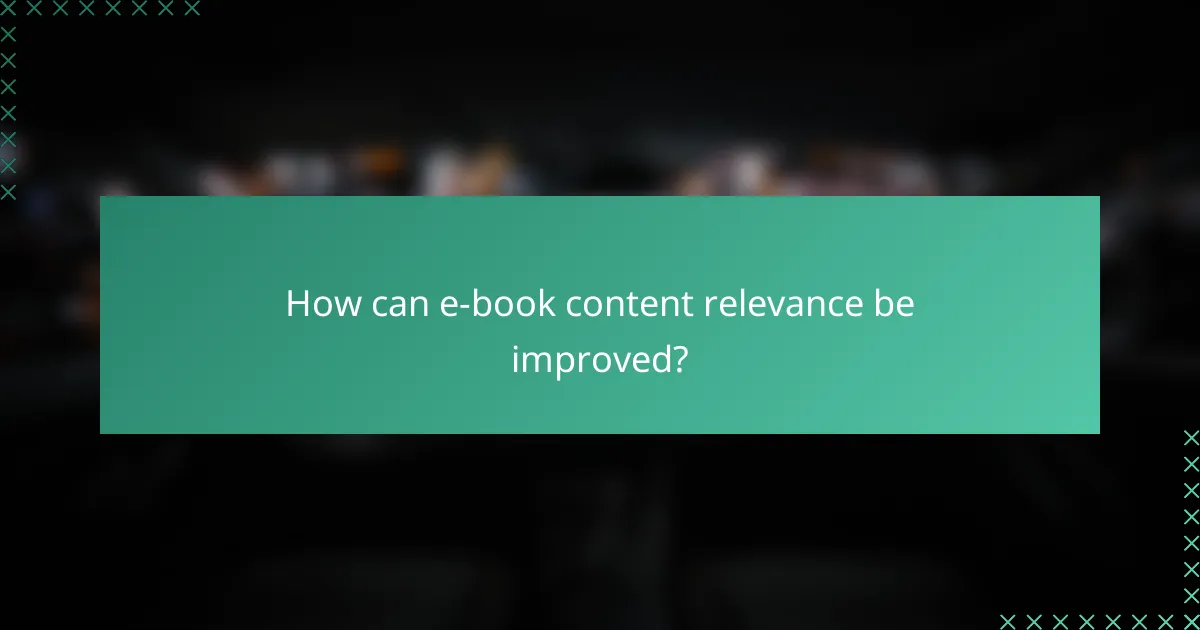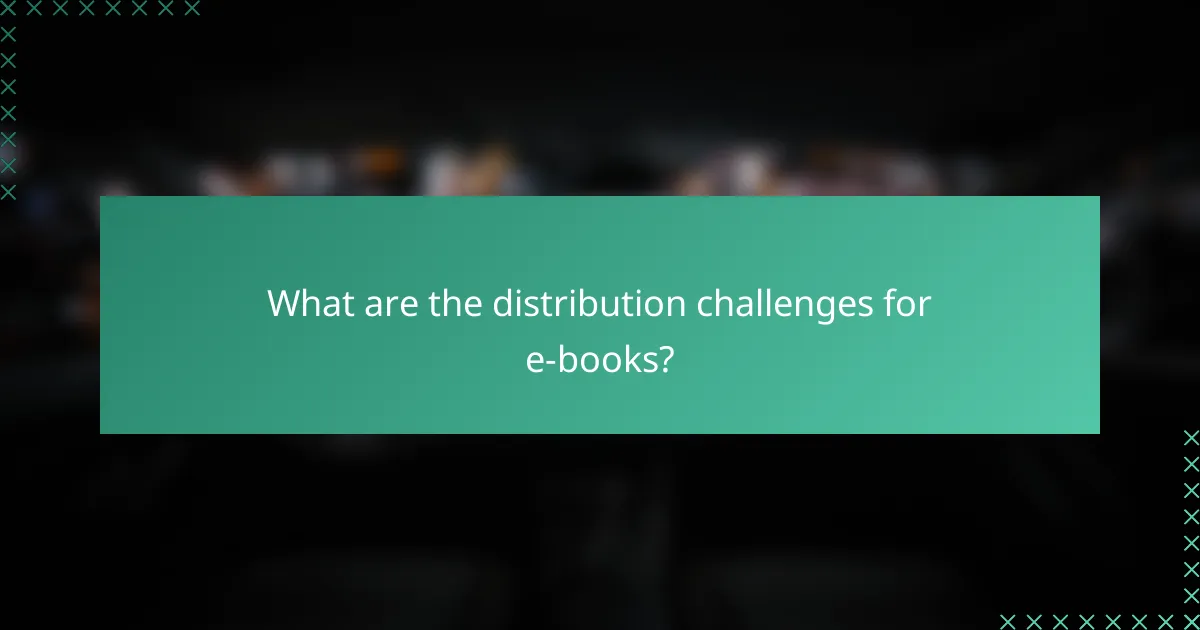E-books have transformed the way readers consume literature, but they come with their own set of challenges, including content relevance, formatting issues, and distribution hurdles. Ensuring that e-books are properly formatted and accessible is crucial for enhancing the reading experience, while understanding audience needs and optimizing content can improve relevance. Additionally, navigating the complexities of e-book distribution, such as platform restrictions and market saturation, is essential for authors aiming to reach a broader audience.

What are the common formatting issues with e-books in Canada?
Common formatting issues with e-books in Canada include inconsistent file formats, improper layout on devices, missing metadata, inaccessible content, and image resolution problems. These challenges can hinder the reading experience and affect the distribution of e-books in the Canadian market.
Inconsistent file formats
Inconsistent file formats can create compatibility issues across different e-readers and devices. Popular formats like EPUB, MOBI, and PDF may not render the same way on all platforms, leading to a fragmented reading experience. Authors and publishers should choose widely accepted formats and consider offering multiple versions to accommodate various devices.
Improper layout on devices
Improper layout occurs when e-books do not display correctly on different screen sizes or orientations. This can result in text being cut off, images misaligned, or navigation links failing to work. To avoid these issues, it’s essential to test e-books on multiple devices and use responsive design techniques to ensure a consistent layout.
Missing metadata
Missing metadata can significantly impact the discoverability of e-books in online stores and libraries. Essential information such as title, author, genre, and keywords should be included to enhance searchability. Publishers should ensure that all relevant metadata is correctly embedded in the e-book files before distribution.
Inaccessible content
Inaccessible content refers to e-books that do not meet accessibility standards for readers with disabilities. This can include a lack of alt text for images, improper heading structures, or non-compliant text-to-speech functionality. Following accessibility guidelines, such as WCAG, is crucial to ensure that all readers can enjoy the content.
Image resolution problems
Image resolution problems arise when images in e-books are either too low or too high in resolution, affecting clarity and loading times. Low-resolution images can appear pixelated, while high-resolution images may increase file size unnecessarily. Aim for a balance by using images that are optimized for digital display, typically around 72 DPI for screens.

How can e-book content relevance be improved?
Improving e-book content relevance involves understanding your audience, optimizing for search engines, and keeping the material updated. These strategies ensure that the content resonates with readers and remains accessible in a competitive market.
Target audience analysis
Conducting a thorough target audience analysis is essential for enhancing e-book content relevance. Identify demographics such as age, interests, and reading habits to tailor your content effectively. Use surveys or social media insights to gather data on what your audience values and seeks in e-books.
Once you understand your audience, create reader personas that represent different segments. This helps in crafting content that speaks directly to their needs and preferences, increasing engagement and satisfaction.
Keyword optimization
Keyword optimization is crucial for improving the discoverability of your e-book. Research relevant keywords that potential readers might use in search engines to find content similar to yours. Tools like Google Keyword Planner or SEMrush can help identify popular search terms.
Incorporate these keywords naturally into your e-book’s title, headings, and body text. Aim for a keyword density of around 1-2% to avoid keyword stuffing, which can negatively impact readability and search rankings.
Regular updates and revisions
Regular updates and revisions keep your e-book content relevant over time. Set a schedule to review and refresh your material, ideally every six months to a year, depending on the subject matter. This ensures that your content reflects the latest trends and information.
When revising, consider reader feedback and analytics to identify sections that may need enhancement or clarification. Updating your e-book can also improve its ranking in search results, as search engines favor fresh content.

What are the distribution challenges for e-books?
Distribution challenges for e-books include navigating platform restrictions, market saturation, pricing strategies, and limited marketing reach. These factors can significantly impact an author’s ability to successfully distribute their e-books to a wider audience.
Platform restrictions
Many e-book platforms impose specific restrictions that can limit distribution options. For instance, some platforms may require exclusive rights to publish, which can prevent authors from reaching readers on other sites. Understanding the terms of each platform is crucial for maximizing exposure.
Additionally, different platforms have varying formatting requirements and submission processes. Authors should familiarize themselves with these guidelines to avoid delays or rejections during the distribution process.
Market saturation
The e-book market is highly saturated, making it challenging for new titles to stand out. With millions of e-books available, authors must find unique ways to differentiate their work. This can involve niche targeting or innovative marketing strategies to capture potential readers’ attention.
To navigate saturation, authors might consider collaborating with influencers or using social media campaigns to boost visibility. Engaging with reader communities can also help in building a loyal audience over time.
Pricing strategies
Setting the right price for an e-book is essential for successful distribution. Authors must balance affordability for readers with the need to generate revenue. Common strategies include introductory pricing, discounts, or bundling with other titles to attract buyers.
Researching competitor pricing can provide insights into effective pricing models. Authors should also consider regional pricing variations, as what works in one market may not be effective in another.
Limited marketing reach
Many authors face challenges in marketing their e-books effectively due to limited resources or knowledge. Without a robust marketing plan, even the best e-books may go unnoticed. Authors should explore various marketing channels, including social media, email newsletters, and online advertising.
Building an author platform and engaging with readers through blogs or podcasts can enhance visibility. Networking with other authors and participating in book fairs or online events can also expand marketing reach and foster community support.

What criteria should be considered for e-book formatting?
When formatting e-books, key criteria include ensuring device compatibility and adhering to readability standards. Proper formatting enhances user experience and accessibility across various platforms and devices.
Device compatibility
Device compatibility is crucial for e-books, as they must function seamlessly on a range of devices, including e-readers, tablets, and smartphones. Common formats like EPUB and MOBI are widely supported, but it’s essential to test your e-book on multiple devices to ensure consistent performance.
Consider the specific features of each device, such as screen size and resolution, which can affect layout and readability. For example, a layout that looks good on a tablet may not translate well to a smaller e-reader screen.
Readability standards
Readability standards focus on how easily users can read and comprehend the text. Factors include font choice, line spacing, and paragraph structure. Use standard fonts like Arial or Times New Roman, and maintain a font size of at least 12 points for optimal legibility.
Additionally, consider the use of headings, bullet points, and short paragraphs to break up text and enhance clarity. Avoid overly complex layouts that may confuse readers or disrupt the flow of reading.

How does e-book distribution differ in Canada?
E-book distribution in Canada involves unique considerations, including regional preferences, local regulations, and market dynamics. Understanding these factors is crucial for authors and publishers aiming to effectively reach Canadian readers.
Content Relevance
Content relevance in Canadian e-books hinges on cultural context and language preferences. Canadian readers often seek material that reflects their diverse backgrounds, including English and French content, as well as Indigenous perspectives.
Authors should consider regional interests and current events that resonate with Canadian audiences. Tailoring content to include local themes can enhance engagement and sales potential.
Formatting Issues
Formatting e-books for the Canadian market requires attention to various standards and devices. Common formats like EPUB and MOBI are widely accepted, but ensuring compatibility across different e-readers is essential.
Pay attention to font choices, layout, and interactive elements, as these can affect readability. Testing e-books on multiple devices can help identify and resolve formatting issues before distribution.
Distribution Challenges
Distributing e-books in Canada presents challenges such as navigating regional platforms and understanding local copyright laws. Major retailers like Amazon and Kobo dominate the market, but smaller platforms may also be relevant.
Authors should research distribution channels that align with their target audience. Additionally, awareness of Canadian copyright regulations is vital to avoid legal pitfalls and ensure fair compensation.
